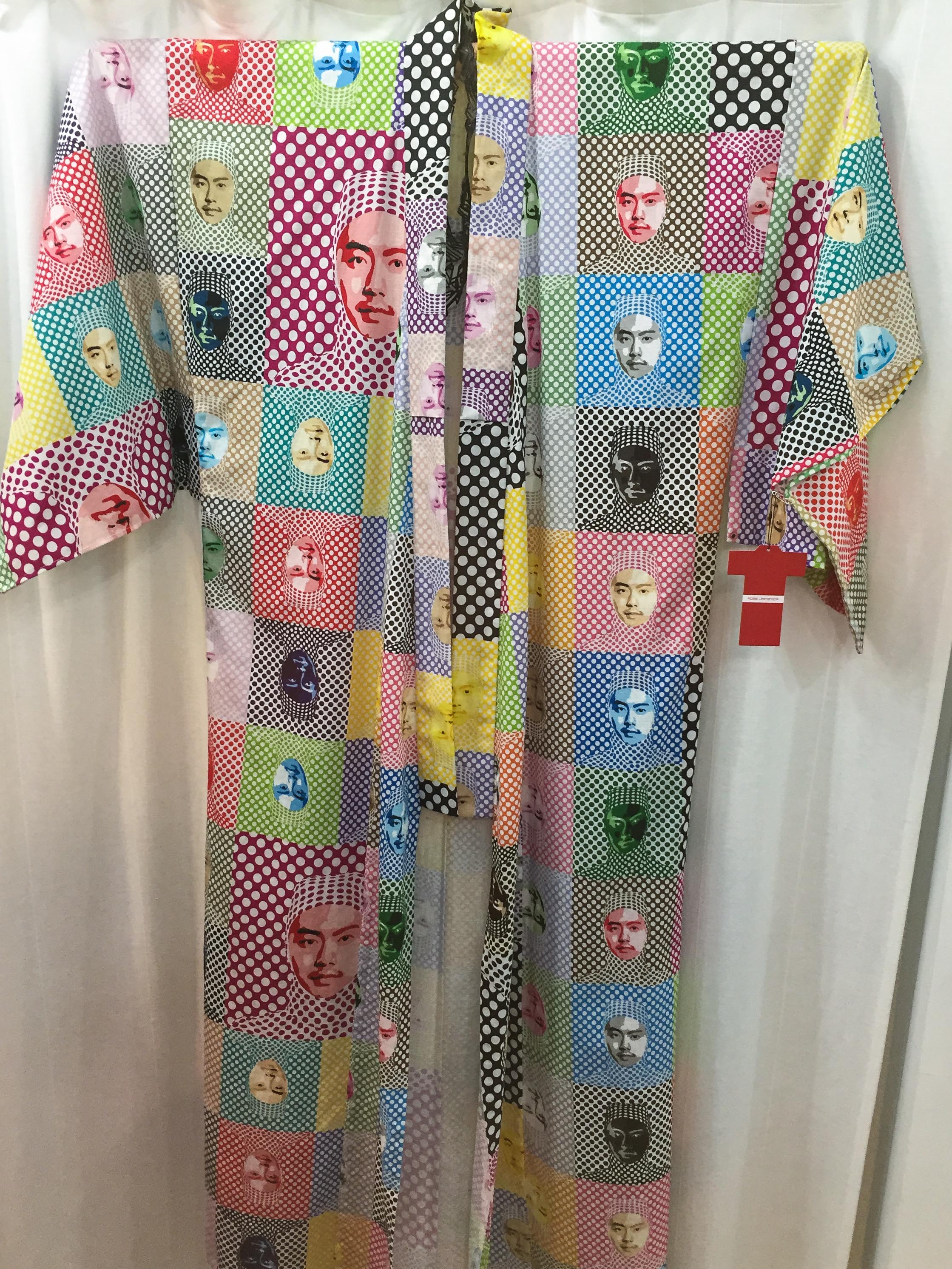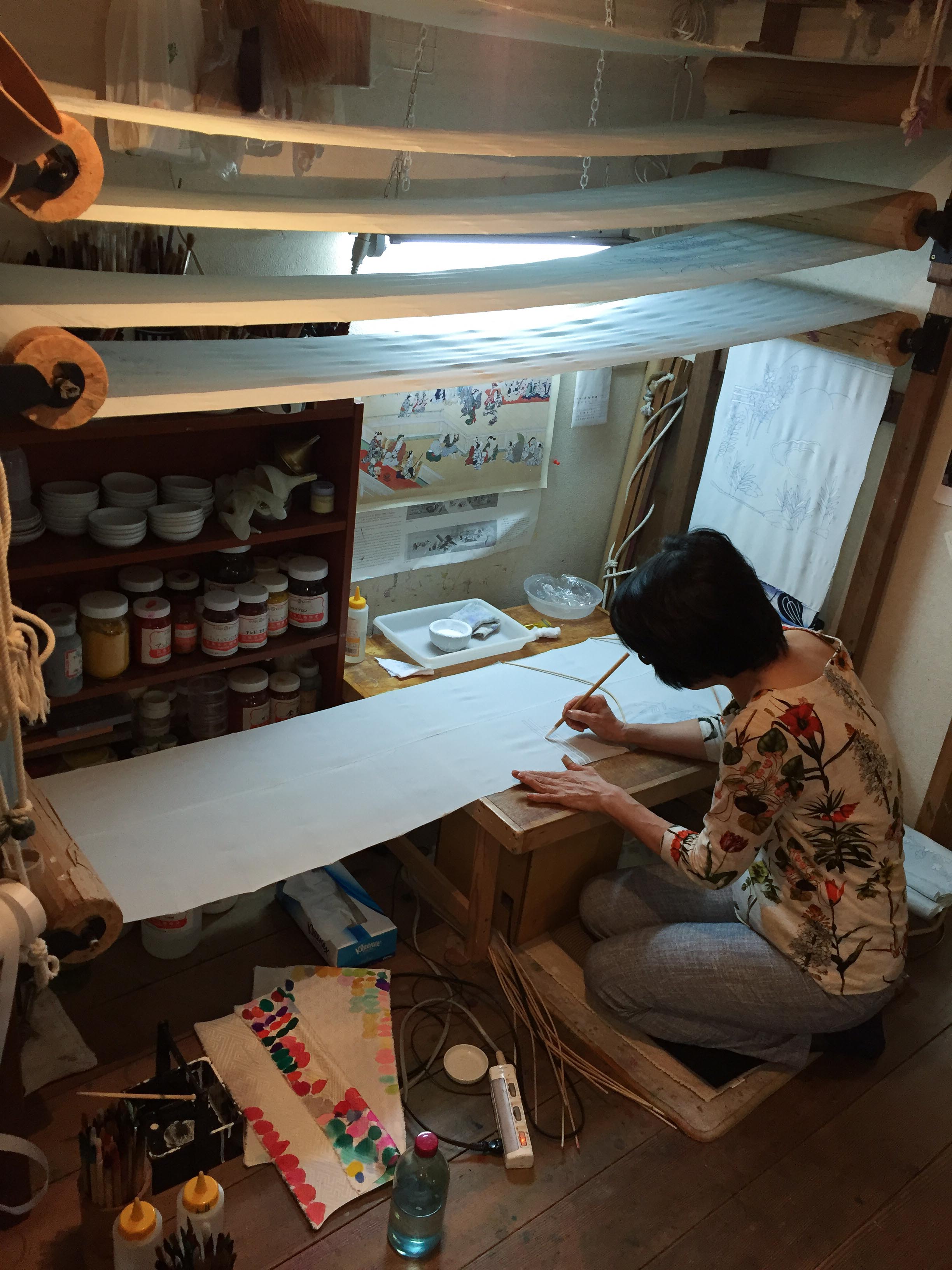BLOG
Kimono Style – A Guide
Guest post by Martin McKellar
I respect the versatility of traditional Japanese kimono.
What could give more convenience than a sleeve, the end of which serves as a pocket? How many times have I had to wrestle an item out of my front pocket while I sit scrunched up in the car in traffic? The act borders on the impossible. The average men’s haori and nagajuban have the sleeve end sewn shut from the bottom to halfway up the sleeve opening. The wearer can keep items like a cellphone, wallet, or handkerchief in this pocket area to access them easily.
I appreciate the cool and loose fitting (i.e. adaptable) garments that don’t need zippers, buttons or velcro. I can suspend a modern day version of a tobacco pouch from my obi and substitute it with car keys or other sundries. I can tuck up the bottom of a yukata into the obi or I can shed the top and let it hang from the obi, if an activity or the weather necessitates.
These advantages got me thinking about what types of kimono designs are still available to Japanese people today. Below is a list of good options available in Tokyo, Kyoto and Osaka:
Vintage kimono
The Tokyo based author and professor, Sheila Cliffe, Ph. D., gave me a tour of used kimono vendors in Tokyo. The quality ranges from vendor to vendor, but the biggest surprise came from the Oriental Bazaar. I have a strong aversion to cliched and superficial tourist fare. I cringe when I walk into a place like Oriental Bazaar. But, relatively hidden on the second floor, they have a decent collection of vintage men’s kimonos. The condition of the kimonos, the range of textiles and the price make this an attractive stop. On a recent trip I found a deep blue, slightly iridescent kimono long enough for me. It was made from a fabric in which the weft thread naturally extends from the fabric at different lengths, a rarely used weaving technique. I also found a black summer kimono, with an ikat design, made from asa. It had a nice crisp feel, a good length, and a reasonable price. The men’s kimonos on the second floor of Oriental Bazaar attract little attention, and I have kept the place a secret from other tourists. So, if you’re interested, the men’s kimonos should be there. It’s worth a look.
My greatest excitement for vintage kimono is reserved for a shop in Kyoto called Konjaku Nishimura. I never come to Kyoto without visiting at least once. The Nishimuras, both father and son, welcome me to their store and provide informative, pleasant conversation. The three modest-sized rooms are filled with vintage textiles, kimono and related objects. It is here that I first saw fragments of damaged kimonos cropped and framed in such a way that adds to the power of the design. Visiting this store gives me the same pleasure I get from visiting Kyoto’s famous temples and shrines.
New Textile Designs for Traditional Kimono Patterns
I discovered Robe Japonica while strolling in the Kiyomizu-dera neighborhood of Kyoto. I saw the president and designer, Taro Ueoka, standing in the doorway of a kimono shop, wearing one of his eye-catching designs. I eagerly entered the shop and asked for men’s kimonos, or ideally, the less expensive summer yukata. An English-speaking sales person took me upstairs to a small, brightly-lit room full of men’s kimono and yukata. I discovered that Mr. Ueoka had a pop-up shop that closed that same day, after which he would return to his Tokyo shop. Perfect — I would return to Tokyo in the next two days. He have me his business card and the address of his shop in the Harajuku neighborhood of Tokyo.
His shop didn’t disappoint.
Mr. Oyama explained to me the philosophy behind Robe Japonica. The store developed new textile designs for use on traditional, and almost traditional, kimono styles. Below I have a photo of the first yukata that caught my eye. Still available when I went in July, customers have bought all available stock since. As you look over the website for Robe Japonica, you’ll notice that some designs have sold out — very popular.

Martin McKellar
I have so many questions about this kimono that I can’t decide if I like it or not. I asked if the image represented a ninja. Mr. Oyama said it did not. It looks like one, don’t you think? It has a color and visual impact that I have never seen in a man’s kimono.
The design of the second yukata that Mr. Oyama brought to my attention was what he calls “Samurai Camo.” If you look closely, you’ll see he composed the design of samurai warriors in five different colors.

Martin McKellar
Don’t miss the plexiglass geta!
Traditional kimono designs on new kimono patterns
Last year I discovered Sou Sou, a store in Kyoto. I was in a rush and didn’t have time to carefully look at the merchandise. But, the sales staff gave me a card for their Tokyo store in the Ginza neighborhood. I returned to Tokyo and found my way there. The style of their clothes reference kimono lines but have modifications that approach a contemporary style. That said, nothing in their store looked like something quiet enough for me to wear. In the end, I left disappointed.
This year I had the opposite reaction. First of all, Sou Sou has prospered. I went into the Sou Sou shop in Kyoto and asked for the men’s clothes. The sales staff told me that Sou Sou has six shops in a row, on the same street! I had entered the first shop, but the men’s clothes were located in the sixth.
For it’s attractive dark indigo blue color, I bought the men’s shirt pictured below. And, due to its conservative design, I will not feel self-conscious when I wear it.

Sou-Sou chijimi silk crepe kimono top – Martin McKellar
Notice that the collar mimics a kimono collar but it doesn’t extend down the front of the shirt. It has a second collar inside the first, as if the wearer wore a naga-juban or under-kimono. Laid out flat like this, you can see this references typical kimono design with each arm equal to one fourth the width of the garment. It is as if the designer had made the garment from four sections of cloth, all of equal width. Here is a close up of the collar.
Although I have focused on Sou-Sou garments that retain traditional colors and textile designs, a look at their on-line shop will demonstrate that they also offer many bright, contemporary designs as well.
Creating new kimono using centuries-old techniques
Right around the corner from my sharehouse in Tokyo was a studio run by Masako Tada. Less than 24 hours before I left the city, I had a chance to talk to her. She graciously invited me into her shop, made tea, and explained: she created textiles, and uses them to clothe dolls. Customers commission the dolls, and can request specific aspects of the textiles like color or image. Ms. Tada also is a teacher of textiles and kimonos. She showed me intricate designs her students had put onto rolls of silk. The students favor designs found on traditional kimonos and, in this way, imbue new kimonos with traditional techniques. The photo below shows one of her students working on silk fabric. She will make her own kimono out of the fabric.

In the workshop of Masako Tada – Martin McKellar
Notice the clever way she uses rollers to position the long length of silk. The recently painted silk needs a chance to dry. However, I am not sure why she keeps the entire length of silk separated from itself, i.e. not rolled up.
Creating new kimono using new technology
There remains another, more modern method to make a kimono for today’s customer. At Ichiroya, located in Osaka, customers can chooses from a large variety of designs, and garments, color combinations online. Ichiroya then prints the design on polyester using the latest printing techniques. The textiles are finally sent to an expert tailor who makes the requested item of clothing. This allows the buyer to obtain kimono in larger sizes, and in easy-to-clean fabric that retains the look of a traditional kimono. Currently, Ichiroya only offers women’s designs. However, in the future, they may expand to include men’s clothing too. They have an English language online shop called Kimonotte Factory.
It surprised me to discover the many ways that my contemporaries, Japanese and foreign, can bring kimono culture into their lives. I have described five. Do you know of a sixth? If so, please let me know! Of course, each approach has its own strengths and weaknesses, but I prefer two of the five: buying authentic vintage kimonos, and buying clothes from Sou-Sou, which reference kimono design that I can wear in or outside of Japan.



